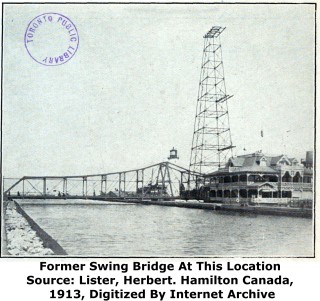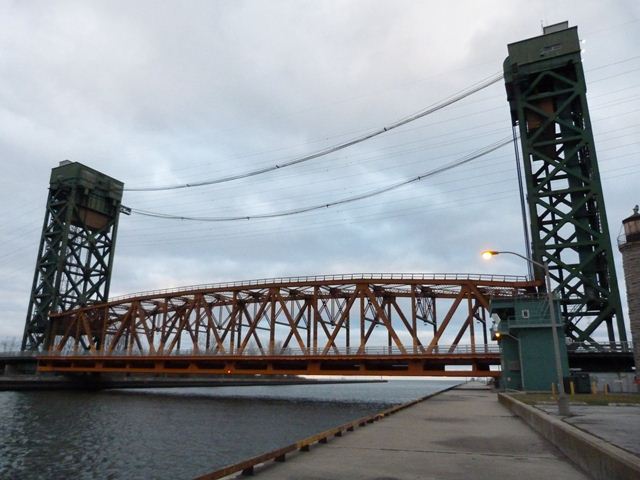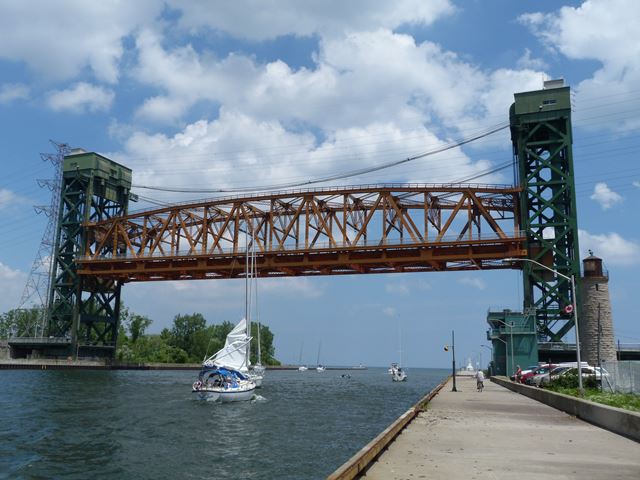We Recommend:
Bach Steel - Experts at historic truss bridge restoration.
BridgeHunter.com Phase 1 is released to the public! - Visit Now
Burlington Canal Lift Bridge

Primary Photographer(s): Nathan Holth
Bridge Documented: December 23, 2012 and June 29, 2014
Burlington and Hamilton: Halton Region, Ontario and Hamilton City, Ontario: Canada
Metal 12 Panel Rivet-Connected Polygonal Warren Through Truss, Movable: Vertical Lift (Tower Drive)
1962 By Builder/Contractor: Hamilton Bridge Company of Hamilton, Ontario and Engineer/Design: C. C. Parker and Associates of Hamilton, Ontario
1982
380.0 Feet (115.8 Meters)
Not Available
65 Feet (19.81 Meters)
1 Main Span(s)
Not Applicable

View Information About HSR Ratings
Bridge Documentation
Additional Information: Robert McAlpine Limited of Weston, Ontario was the substructure contractor for the bridge.
View An Article About The Replacement of This Bridge's Main Counterweight Ropes
This bridge, completed in 1962, is a late example of a vertical lift bridge. However, the bridge is nevertheless old enough so that it has details not found on modern bridges like built-up beams with rivets as well as lattice bars (those being found in the bracing). In contrast, some built-up members (particularly those in the truss web) use plate with holes in place of lattice, a variety typical of 1950s and 1960s bridges. The bridge is also significant for its very long lift span, a length unequaled by most older lift bridges.
The bridge is not the first at this location. A swing bridge was once located at this crossing. In 1922, this was replaced by a single leaf Strauss heel-trunnion type bascule. An interesting story about this bridge is that in 1931 the canal was widened, and to accommodate this, a second bascule bridge was added at the other side of the canal to form a double leaf bascule bridge. On April 29, 1952, the freighter W. E. Fitzgerald collided with and destroyed one of the spans, which led to the design and construction of the existing lift bridge. The lift bridge superstructure was built by the company that is generally known as the Hamilton Bridge Company but changed its name many times over its operation and at the time was officially called the Hamilton Bridge and Tank Company. The buildings for the bridge were built by McAlpine Construction Company. The lift bridge was the longest and heaviest in Canada when completed. The lift span weight when completed was 2,100 tons. The bridge was designed for a single railway track of the Hamilton-Northwestern railway as well as a two lane roadway. In 1982, the tracks were removed, and the roadway was widened. The current weight of the lift span is 2200 tons (2000 tonnes).
The bridge has a vertical lift capacity of of 110 feet (33.5 meters). There is one 150 hp drive motor in each of the two towers to raise and lower the bridge, and an additional 150 hp motor in each tower to synchronize the drive motors in each tower. The bridge continues to operate for boats frequently. In 2004, the average lifts per year was reported as 4200 lifts.
The designer of this bridge, C. C. Parker and Associates is today part of Stantec Consulting.

This bridge is tagged with the following special condition(s): Unorganized Photos
![]()
Photo Galleries and Videos: Burlington Canal Lift Bridge
2012 Bridge Photo-Documentation
Original / Full Size PhotosA collection of overview and detail photos. This gallery offers photos in the highest available resolution and file size in a touch-friendly popup viewer.
Alternatively, Browse Without Using Viewer
![]()
2012 Bridge Photo-Documentation
Mobile Optimized PhotosA collection of overview and detail photos. This gallery features data-friendly, fast-loading photos in a touch-friendly popup viewer.
Alternatively, Browse Without Using Viewer
![]()
2014 Additional Unorganized Photos
Original / Full Size PhotosA supplemental collection of photos that are from additional visit(s) to the bridge and have not been organized or captioned. This gallery offers photos in the highest available resolution and file size in a touch-friendly popup viewer.
Alternatively, Browse Without Using Viewer
![]()
2014 Additional Unorganized Photos
Mobile Optimized PhotosA supplemental collection of photos that are from additional visit(s) to the bridge and have not been organized or captioned. This gallery features data-friendly, fast-loading photos in a touch-friendly popup viewer.
Alternatively, Browse Without Using Viewer
![]()
Bumpercam: Northbound Crossing
Full Motion VideoNote: The downloadable high quality version of this video (available on the video page) is well worth the download since it offers excellent 1080 HD detail and is vastly more impressive than the compressed streaming video. Streaming video of the bridge. Also includes a higher quality downloadable video for greater clarity or offline viewing.
![]()
Bridge Raising and Lowering
Full Motion VideoNote: The downloadable high quality version of this video (available on the video page) is well worth the download since it offers excellent 1080 HD detail and is vastly more impressive than the compressed streaming video. Streaming video of the bridge. Also includes a higher quality downloadable video for greater clarity or offline viewing.
![]()
Maps and Links: Burlington Canal Lift Bridge
Coordinates (Latitude, Longitude):
Search For Additional Bridge Listings:
Additional Maps:
Google Streetview (If Available)
GeoHack (Additional Links and Coordinates)
Apple Maps (Via DuckDuckGo Search)
Apple Maps (Apple devices only)
Android: Open Location In Your Map or GPS App
Flickr Gallery (Find Nearby Photos)
Wikimedia Commons (Find Nearby Photos)
Directions Via Sygic For Android
Directions Via Sygic For iOS and Android Dolphin Browser





